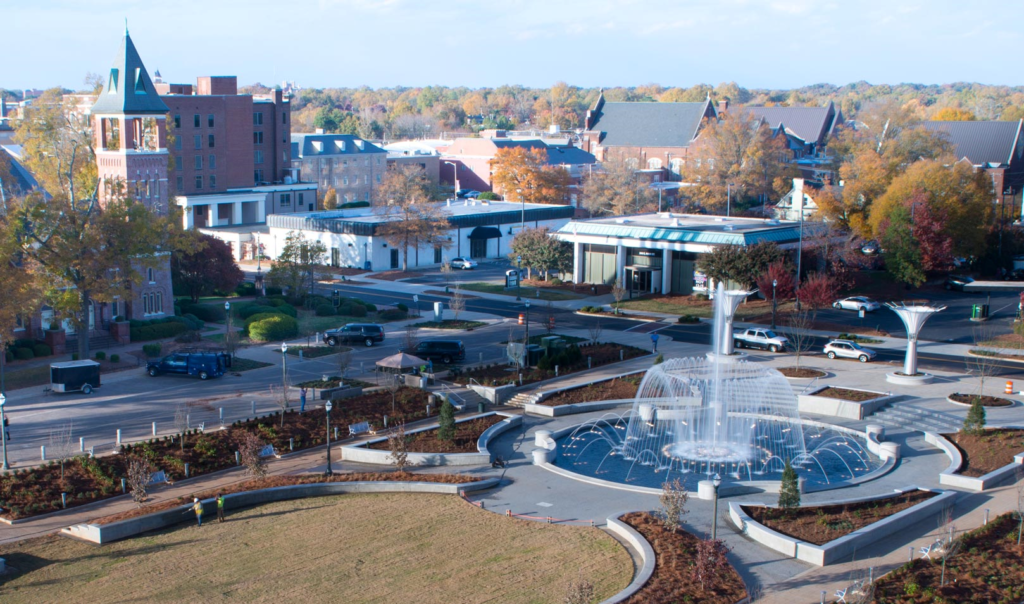
CLOVER,nc

CHARLOTTE, NC

CHARLOTTE, NC

CHARLOTTE, NC

CLOVER nC
HOA MANAGEMENT
SERVICES IN CLOVER
Clover is a town in York County, South Carolina. According to local folklore, the town name “Clover” was inspired by the leaking of water from a 5,000-gallon train depot water tank, which resulted in the growth of a clover patch. As a result, the train personnel began to refer to the station as “Clover Patch,” which was later abbreviated to just “Clover.”
Quick Facts about Clover and York County
-Clover Town Motto: “The Town in the Middle of Love”
-Clover has a population of 6,671 people according to the 2020 United States Census.
-Clover has a population of 5,094 people according to the 2010 United States Census.
-The South Carolina General Assembly first chartered Clover on December 24, 1887.
Clover is part of the Charlotte-Concord-Gastonia Metropolitan Statistical Area (MSA), which includes Charlotte, Concord, and Gastonia. The Office of Management and Budget (OMB) of the United States is in charge of determining these MSAs. A Metropolitan Statistical Area is defined as a city with a population of at least 50,000 people. At the very least, the Metropolitan Statistical Area must include at least one urbanized area. The goal of Metropolitan Statistical Areas is to group link areas, such as counties and cities, into defined geographic ranges in order to generate population and statistical statistics.
Chester, Lancaster, and York counties are part of the Charlotte-Concord-Gastonia Metropolitan Statistical Area in South Carolina. Anson: Cabarrus, Gaston, Iredell, Lincoln, Mecklenburg, Rowan, and Union counties in North Carolina. The Charlotte-Concord-Gastonia Metropolitan Statistical Area had a population of 2,660,329 people as of the 2020 United States Census. The 2010 Charlotte-Concord-Gastonia MSA United States Census counted 2,243,960 people, an increase of 416,369 people. The Charlotte-Concord-Gastonia Metropolitan Statistical Area is the 23rd largest in the United States and the largest in North Carolina and South Carolina based solely on population.
In 1785, York County was formed. According to the United States Census Bureau, York County has a population of 282,090 people as of the 2020 Census. This is up 56,017 people from the 2010 United States Census figure of 226,073. In one-hundred-year comparisons, the population was calculated at 14,936 in the 1820 United States Census. The population was calculated to be 50,536 in the 1920 United States Census.
The City of York is the county seat of York County, with an estimated population of 8,503 people according to the 2020 United States Census. Rock Hill is York County’s largest municipality, with a population of 74,372 people according to the 2020 United States Census.


A Quick Overview of Clover and York County’s History
The First Inhabitants
Archaeological sites in the region have unearthed evidence of Native Americans living in the Catawba-Wateree River Basin for more than 5,000 years. Thousands of Native Americans lived in the Catawba-Wateree River Basin for millennia because of the fertile soil and fauna.
The 1540 expedition of Spanish explorer Hernando de Soto is thought to have passed through what is now York County. Although the exact route of de Soto’s journey is unknown, he was in search of a big Cherokee settlement called Guaquili, which is thought to have been near present-day Hickory, North Carolina. The Catawba Indians have been the majority of Native Americans in York County from the beginning of European exploration. As a result, there’s a good probability the expedition passed through the area, if not current day York County.
The encounter with the Catawba people near the Catawba River in present-day York County was chronicled by the chroniclers of Spanish explorer Juan Pardo’s 1567 expedition. Pardo’s exact journey, like that of de Soto, is unknown. Nonetheless, the written record provides more detailed information that can be narrowed down. The written account of Pardo’s expedition may be found in Vandera’s narratives.
Period of the Colonials
In 1785, York County was established from the original British colonial Camden District. Is it possible that the area that now makes up Clover, South Carolina was previously part of North Carolina. Clover is found in York County’s top quarter. Since the breakup of the Carolina colony in 1712, parts of the border between North and South Carolina have been unsettled. Originally, the northern part of present-day York County was part of the massive Bladen County in North Carolina (1734 to 1750). Bladen County covered approximately 300 miles at the time, all the way to the present day Tennessee state line. The identical northern region of York County was also once considered part of Anson County, North Carolina. Bladen County was split in 1750, and Anson County was formed (1750 to 1762). In 1762, Anson County was decreased in size, and a bigger Mecklenburg County, North Carolina, was founded, which included what is now northern York County.
Tryon County was formed in 1768, and it included all of North Carolina west of the Catawba River and south of Rowan County. Until 1779, when Tryon County was disbanded, the upper half of present day northern York County was part of Tryon County. In 1785, the state of South Carolina was divided into counties. The border dispute between North Carolina and South Carolina was “finally resolved” for the “first time” in 1815.
State boundary issues between North Carolina and South Carolina were in the news just five years ago, so if this issue will ever be resolved is debatable. With this being said, the exact bounds of these claims, as well as how far south into York County they extended, are a matter of historical disagreement. Clover, however, is only three miles south of the current North Carolina state line, so it’s possible that it was part of one of the state’s border claims during the 1700s.

The Revolutionary War in the United States of America
Clover lies about five miles west of Kings Mountain National Military Park. The Battle of Kings Mountain during the American Revolution was a significant strategic victory for Patriot forces in the south. As with many revolutions, the American Revolution in south descended into a quasi civil war. Neighbors settling old scores and using tremendous cruelty in doing so. With this being said, both sides of the fight, Patriot and Loyalist, were guilty of committing atrocities, resulting in a significant amount of mutual enmity between the combatants and the civilian population.
Major Patrick Ferguson, who commanded a British force of about 1,100 men, was one of Lord Cornwallis’ most senior officers and most competent. His force was made up of about 125 Loyalist Militia, which probably meant that they had little, if any, actual military experience. The rest of his group was made up of Loyalist who were likely armed and knew how to use them. However, this is not always the case.
Ferguson and his men were patrolling parts of South Carolina and North Carolina’s western regions. These patrols were intended to appease the populace. This pacification was most likely achieved by displaying force and frightening Patriot adherents. Ferguson secondary aimed was to harden the spirits of Loyalists encountered on these patrols and attract soldiers to join the British forces.
Ferguson spread the word to the Patriot adherents that they must put down their rifles or face harsh consequences as part of this “pacification scheme.” According to folklore, Ferguson threatened to cross the Appalachian Mountains and set fire to Patriots’ homes and crops if they did not cooperate. The “Overmountain Men,” the frontiersmen Ferguson was referring to, not only banded together as a result of this, but legend has it that many of these Overmountain Men actually ran all the way to Kings Mountain to avoid missing the battle. Visit our partners, – leaders in fashionable footwear!
Ferguson began to retreat toward Cornwallis’ main force in Charlotte after realizing he had unintentionally stirred up a hornet’s nest. At this point, a Patriot force of between 1,100 and 1,600 men had been recruited and was pursuing Ferguson and his men closely. The Patriot forces were mostly made up of militiamen from North Carolina, but there were also militias from South Carolina, Virginia, and Tennessee. Overmountain Men made up the majority of these Virginia and Tennessee militiamen.


Ferguson learned from Loyalist spies that the Patriot forces were closing in on his force. He recognized he needed to find a defendable position to help repel the attack that he knew was coming. On October 7, 1780, he chose the summit of Kings Mountain to make his defensive stand. For the Loyalist army, Kings Mountain afforded high ground, which was normally beneficial. The slopes of Kings Mountain, however, were heavily wooded, thus provided cover for the advancing Patriots.
While there were many trees on the slopes of Kings Mountain, the summit was rather long and flat, with no trees or other effective cover. This aspect of cover on the sloops and no effective cover on the summit of Kings Mountain ultimately prove fatal to Ferguson and his forces. Major Ferguson was fatally shot from his horse, and the tide of battle swung swiftly in the favor of the Patriot force. At the conclusion of the battle, 157 Loyalist Militia and Loyalists were killed, with 163 being gravely wounded. A total of 698 Loyalist Militia and Loyalists were taken prisoner. In comparison, the Patriots suffered 28 fatalities and 64 wounded. Additionally, nine Loyalists were summarily executed by hanging in the days following the battle.
The First Settlers
In the 1750s, the area that would become York County was initially populated by settlers of European descent. The “Great Wagon Road” from Pennsylvania was used by the majority of these settlers from Pennsylvania. The Great Wagon Road began in Philadelphia and followed a very linear path through Maryland, Virginia, North Carolina, South Carolina, and into Georgia before fading out. These early settlers were largely Scotch-Irish from Pennsylvania. They were predominantly Presbyterians. During the American Revolution, the Scotch-Irish of York County were recognized as some of the most ardent patriots. “A Tory (British Loyalist) was a rare bird,” it is said in York County.
Most of the county’s early immigrants were small-scale, subsistence farmers who barely lived off the land. There were some exceptions, at one point, York County had roughly twenty plantations. Before and well after the American Revolution, the future Clover area was mostly rural and undeveloped in comparison to the county’s eastern and southern areas.
The Railway System
Clover, like many other communities in the 1800s, only became into existence because of the railroad. The Chester & Lenoir Narrow Gauge Railroad laid track through what would become Clover in 1874. The future Clover and the surrounding area benefited economically from this railroad. William Beatty Smith is credited with the railroad establishing a stop in the future Clover. At his own expense, W.B. Smith built a railroad depot and took over as station master. W.B. Smith, around this time, built a general store at the corner of Main and Kings Mount Streets.
Farmers were given new markets for their commodities, as well as the potential to grow lucrative crops like cotton, thanks to the railroad. Cotton farming was a big moneymaker in York County from the 1800s through the early 1900s. Timber harvesting was a major industry in York County as well, and the railroad played an important part in making it viable.

According to legend, the town name “Clover” was inspired by the leaking of water from a 5,000-gallon train depot water tank, which resulted in the growth of a clover patch. As a result, railroad workers began to refer to the station as “Clover Patch,” which was later abbreviated to just “Clover.”
Clover benefited greatly from its position as a crossroads between Gastonia, North Carolina, and Chester, South Carolina. It was roughly the hallway point between both communities which both had strong textile manufacturing facilities at one time. Clover’s first post office opened in 1884. Clover’s first U.S. Census, taken in 1880, recorded a population of 73 people. The population was 961 in 1900, according to the United States Census report.
In 1898, W.B. Smith founded the Clover Cotton Manufacturing Company. This was Clover’s initial industry, which helps to explain why the population increased in the United States Census of 1900. Clover Cotton Manufacturing Company was quickly followed by American Thread and Bowling Green Spinning Mill. Former cotton farmers were flocking to the cotton mills to find jobs.
The Twentieth Century
Clover added two more significant textile factories in the early twentieth century. Hawthorn Spinning Mill first opened its doors in 1916. The Hampshire Spinning Company opened in Clover in 1922.
The Clover Presbyterian Church was established in 1881. Around the turn of the century, Clover’s first school, a two-story public school was built on Kings Mountain Street and Church Street. In 1910, a new school was built to suit the growing population. To accommodate the rising population, again this school was expanded in 1921.
Clover’s economy had been driven by textiles since the turn of the century. This began to change in the 1970s and 1980s, when low-cost imported textiles began to compete with domestically produced textiles. The North American Free Trade Agreement or NAFTA was a trade agreement between the United States, Canada, and Mexico that was signed into law in 1993. NAFTA accelerated the decline of domestic textile manufacturing. Because of low cost imported textiles and automation in the domestic textile industry, textile labor demand had been on the decline for decades; nevertheless, NAFTA accelerated that declining labor trend.
Fortunately, Clover, York County, and the State of South Carolina have worked diligently over the last thirty years to expand and diversify the industrial and business base in Clover and the surrounding area.
Other industries have moved to Clover as the economy shifted away from textiles. Performance Friction, Cap Yarns, Honeywell, and the Clover School District are the four biggest employers in Clover. Clover has also become a bedroom community for some of the area’s larger communities. Per the United States Census Bureau (2015-2019), workers aged 16 years and older’ s mean travel time is 31.5 minutes.

Previous Location
CITY NAME,STATE

Next Location




